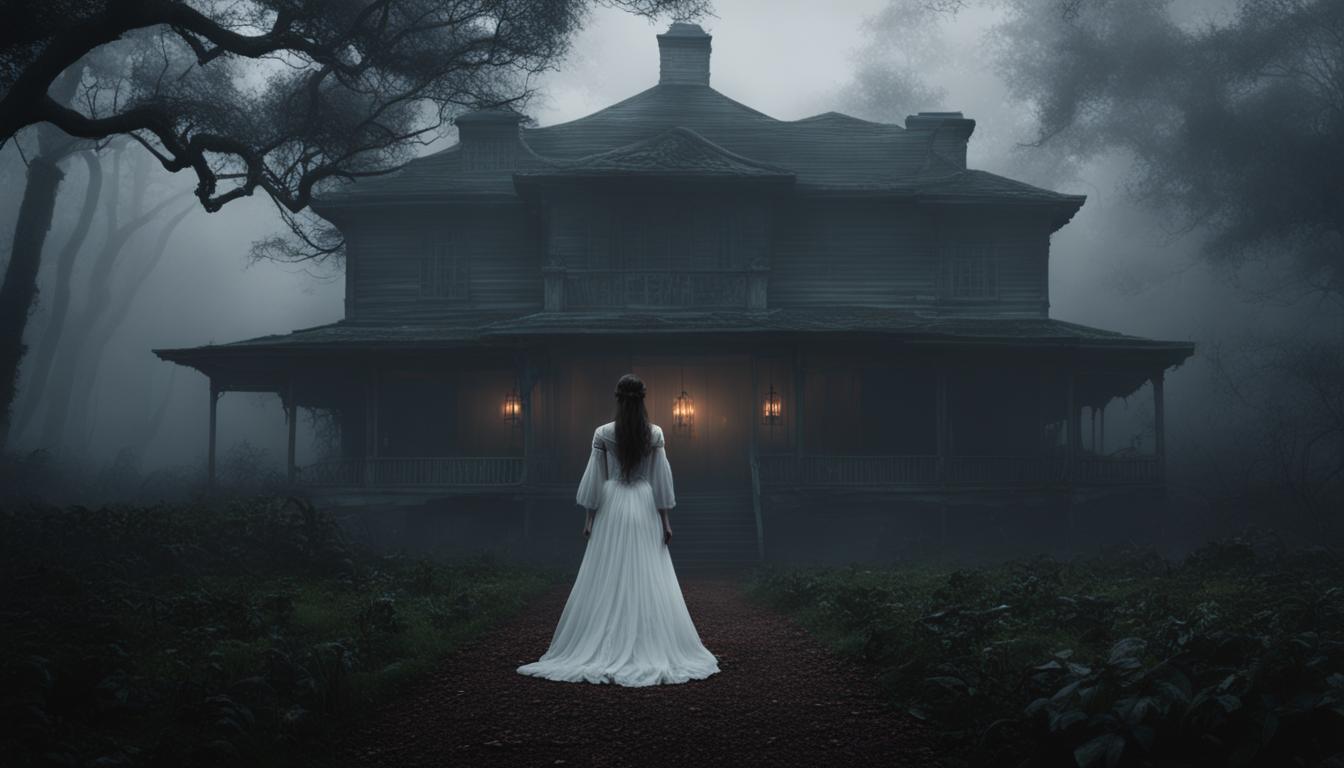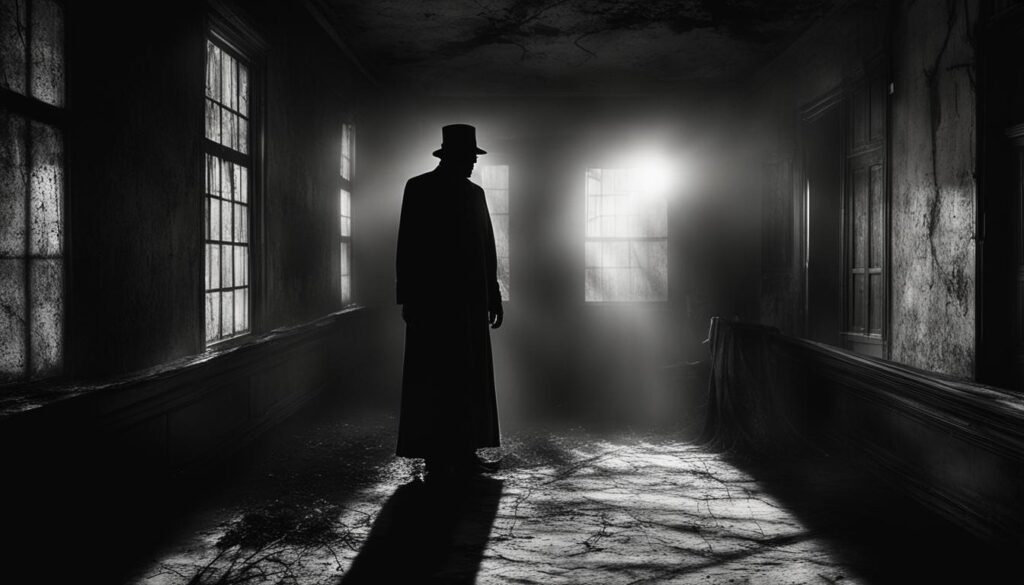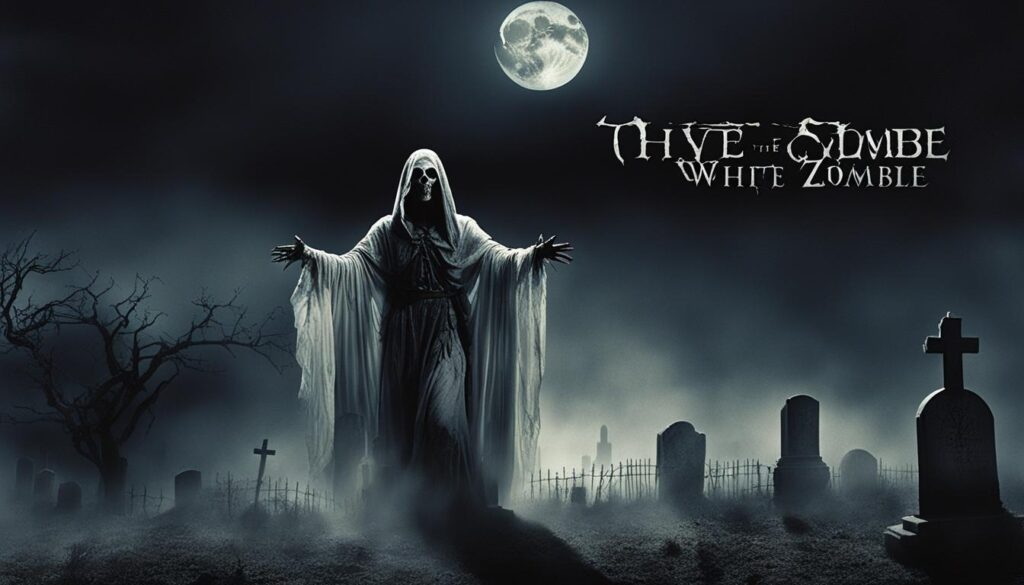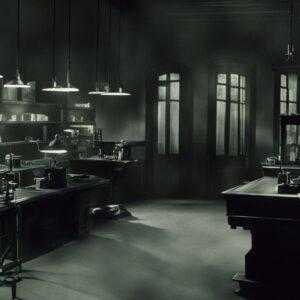Are you ready to dive into the dark and captivating world of classic horror? Look no further than White Zombie (1932), the iconic film that introduced zombies to the big screen. Starring the legendary Bela Lugosi, this movie takes you on a thrilling journey into the realm of voodoo and the undead. Get ready to be haunted by the chilling atmosphere and gripping storyline that have made White Zombie a cult classic in the horror genre.
Key Takeaways:
- White Zombie (1932) is a classic horror movie that marked the birth of the zombie genre.
- Bela Lugosi delivers an iconic performance as the villainous voodoo master.
- The film explores the world of voodoo and showcases its cultural significance.
- White Zombie’s atmospheric cinematography creates a haunting and timeless visual experience.
- This timeless classic continues to captivate audiences and holds its place in cinematic history.
Introduction to White Zombie (1932)
White Zombie (1932) is a vintage horror film that transports viewers to a bygone era of black and white cinema. With its gothic atmosphere and chilling storyline, it has become a beloved classic in the realm of horror. Shot entirely in black and white, the film’s visual style adds to its eerie ambiance, making it a haunting experience for audiences.
Gothic horror is a genre known for its dark and atmospheric settings, and White Zombie (1932) embraces this aesthetic. The film takes place in a mysterious and foreboding world, immersing viewers in a realm where voodoo and the undead coexist. The combination of its vintage production design, shadows, and haunting cinematography creates an atmosphere that continues to captivate audiences to this day.
White Zombie (1932) stands as a testament to the power of early horror cinema. It showcases the effectiveness of black and white imagery in creating suspense and terror, reminding us of the enduring appeal of vintage horror. As a pioneer in its genre, this film laid the foundation for the countless horror movies that followed, leaving a lasting impact on the world of cinema.
The Atmospheric World of Black and White Cinema
“White Zombie (1932) transports viewers back to the golden age of black and white cinema, immersing them in an atmospheric world of shadows and suspense. The film’s vintage production design and haunting cinematography create a unique visual experience that continues to captivate audiences over 90 years later.”
Overall, White Zombie (1932) is not just a classic horror film, but a testament to the enduring power of vintage horror and black and white cinema. Its gothic atmosphere, chilling storyline, and unique visual style make it a must-watch for fans of the genre. This film stands as a true icon of horror cinema, leaving a lasting impact on the world of storytelling.
The Plot of White Zombie (1932)
White Zombie (1932) tells the gripping story of a young couple, Madeleine and Neil, who journey to Haiti to get married. Little do they know that their lives will take a sinister turn when they encounter the twisted and malevolent voodoo master, Murder Legendre.
The couple’s plans for a joyful and romantic wedding soon become a nightmare as Legendre becomes obsessed with possessing the beautiful Madeleine. Employing his dark powers, Legendre transforms Madeleine into a trance-like state, effectively turning her into a zombie under his control. Now, Neil must race against time to save his beloved from the clutches of this malevolent sorcerer and break the spell that has enslaved her.
Throughout the film, White Zombie (1932) delves deep into themes of obsession, power, and the supernatural. The audience is transported into a world where the line between life and death is blurred, and the forces of voodoo magic reign supreme. The chilling and suspenseful plot keeps viewers on the edge of their seats, as they witness a battle of wills unfold between the heroic Neil and the formidable Legendre.
The plot of White Zombie (1932) is a testament to the enduring power of horror storytelling. It captivates audiences with its eerie atmosphere, tense narrative, and the timeless allure of the undead. This classic film continues to be a haunting and thrilling experience for viewers, cementing its place in the annals of horror cinema.
Bela Lugosi’s Iconic Performance
When it comes to the film White Zombie (1932), one cannot overlook the unforgettable performance of Bela Lugosi. Known for his role as Count Dracula, Lugosi brings a commanding presence and a subtle sense of menace to the character of the voodoo master. His portrayal is a masterclass in villainy, captivating audiences with his hypnotic voice and intense gaze.
“Bela Lugosi’s performance in White Zombie is nothing short of mesmerizing. He effortlessly embodies the dark and mysterious voodoo master, mesmerizing viewers with every scene he’s in. Lugosi’s iconic presence adds depth and intrigue to the film, making it a must-watch for any fan of classic horror.” – Horror Review Magazine
Lugosi’s performance in White Zombie is a testament to his talent and versatility as an actor. He seamlessly transitions from charming and charismatic to menacing and sinister, creating a character that lingers in the viewer’s mind long after the credits roll. His portrayal sets the standard for future portrayals of voodoo masters and establishes him as one of the most iconic figures in horror cinema.
From his haunting gaze to his commanding voice, Bela Lugosi’s performance in White Zombie remains a defining aspect of the film. His portrayal of the voodoo master elevates the storyline and adds an air of mystery and danger. It is no wonder that this performance has stood the test of time and continues to be celebrated by horror enthusiasts around the world.
The Influence of Voodoo
White Zombie (1932) incorporates elements of voodoo into its storyline, showcasing the cultural practices and beliefs of Haiti. The film offers a fictionalized representation of voodoo, using it as a tool to drive the plot and create an eerie and otherworldly atmosphere.
Voodoo, a complex Afro-Caribbean religion, often misunderstood and misrepresented, plays a significant role in White Zombie’s narrative. The film highlights the cultural impact of voodoo, exploring its rituals, symbols, and the power it holds over the characters.
The Cultural Significance of Voodoo
White Zombie’s portrayal of voodoo is both intriguing and controversial. While some argue that it perpetuates stereotypes and misconceptions about the religion, others see it as a unique exploration of Haitian cultural traditions.
“White Zombie may not accurately represent voodoo, but it serves as a fascinating example of how the religion has been depicted in popular culture. It’s a reflection of the time and the fascination with the mysterious and exotic.”
The film’s use of voodoo as a plot device resonated with audiences, capitalizing on the fascination with the occult during the early 1930s. It contributed to the popularization of voodoo in Western cinema and laid the foundation for future explorations of the religion in film and literature.
| Voodoo in White Zombie (1932) | Cultural Representation |
|---|---|
| Depicts voodoo rituals and ceremonies | Highlights the cultural practices of Haiti |
| Explores the supernatural elements of voodoo | Captures the mysticism associated with the religion |
| Uses voodoo as a plot device | Drives the narrative and creates an eerie atmosphere |
The Birth of the Zombie Genre
White Zombie (1932) holds a significant place in cinematic history as the film that kickstarted the zombie genre. While the concept of reanimated corpses had been explored in literature and folklore, it was White Zombie that brought zombies to the big screen for the first time. This pioneering film paved the way for countless zombie movies and established the undead as a popular horror subgenre.
White Zombie (1932) introduced audiences to a whole new realm of horror, captivating them with its chilling storyline and atmospheric visuals. The film’s exploration of voodoo, obsession, and the supernatural added a unique twist to the zombie narrative. Its success and influence led to the rise of the zombie genre, with subsequent films building upon the foundation laid by White Zombie.
As the first zombie film, White Zombie (1932) set the stage for the development of this horror subgenre, sparking a global fascination with the undead. The film’s legacy can still be felt today, as zombies continue to dominate popular culture in various forms of media, from movies and TV shows to video games and literature. White Zombie will forever be remembered as the birth of the zombie genre and a significant milestone in the history of horror cinema.
Zombie Genre Comparison
| Feature | White Zombie (1932) | Modern Zombie Films |
|---|---|---|
| Tone | Atmospheric and suspenseful | More action-oriented |
| Gore | Minimal | Graphic and explicit |
| Undead Characteristics | Slow-moving and eerie | Fast and relentless |
| Social Commentary | Minimal | Often used to explore social issues |
| Popularity | Established the genre | Wide variety of films and TV shows |
Despite the evolution of the zombie genre, White Zombie (1932) remains a classic and essential watch for horror enthusiasts. It captures the eerie atmosphere and suspenseful storytelling that set the foundation for future zombie films. Whether you’re a fan of vintage horror or simply interested in the origins of the zombie craze, White Zombie is a must-see film that continues to captivate audiences with its timeless appeal.
The Cinematic Style of White Zombie (1932)
When it comes to creating a truly atmospheric horror film, the cinematography plays a crucial role. In the case of White Zombie (1932), the black and white imagery, combined with unique camera angles and the skilled use of light and shadow, contribute to the film’s haunting visuals. The cinematographers expertly capture the eerie ambiance of the story, drawing viewers into the dark and mysterious world of voodoo and the undead.
One of the standout aspects of the cinematography in White Zombie is the strategic use of light and shadow. The interplay between light and darkness creates a sense of unease, as sinister figures lurk in the shadows, adding to the suspense and tension. Additionally, the film’s black and white aesthetics enhance the otherworldly atmosphere, giving the onscreen events a timeless quality.
The camera angles employed in White Zombie further enhance the film’s haunting visuals. The cinematographers experiment with low angles and close-ups, capturing the eerie expressions of the characters and highlighting their psychological turmoil. These unconventional camera angles create a sense of unease and draw attention to the supernatural elements of the story.
“The cinematography of White Zombie (1932) is a masterclass in creating atmospheric visuals. The strategic use of light and shadow, along with unique camera angles, transports viewers into a world of horror and suspense.” – Film Critic
The Role of Cinematography in Horror
The cinematography in White Zombie showcases the importance of visual storytelling in the horror genre. By skillfully crafting every frame, the cinematographers create an immersive experience that heightens the sense of fear and unease. Through their use of lighting, angles, and composition, they evoke the supernatural elements of the story and enhance the overall atmospheric quality of the film.
| Aspect | Description |
|---|---|
| Light and Shadow | The strategic use of light and shadow creates a sense of suspense and adds to the eerie atmosphere of the film. |
| Black and White Aesthetics | The black and white imagery adds a timeless quality to the visuals, enhancing the otherworldly nature of the story. |
| Camera Angles | The unique camera angles, such as low angles and close-ups, highlight the psychological turmoil of the characters and accentuate the supernatural elements. |
The cinematic style of White Zombie (1932) demonstrates the power of cinematography in creating an atmospheric and visually captivating horror film. Through the careful use of lighting, angles, and composition, the cinematographers bring the dark and haunting world of the film to life, captivating audiences and leaving a lasting impression.
White Zombie’s Cult Following
White Zombie (1932) has garnered a dedicated cult following over the years. The film’s atmospheric storytelling, unconventional plot, and iconic performances have captivated horror enthusiasts around the world. Fans of the genre appreciate the unique blend of voodoo, gothic horror, and the macabre that White Zombie brings to the screen.
What sets White Zombie apart from other horror films is its ability to create a sense of suspense and unease. The black and white cinematography, haunting visuals, and eerie atmosphere contribute to the film’s timeless appeal. Bela Lugosi’s portrayal of the villainous voodoo master further adds to the cult status of the movie.
White Zombie’s fanbase continues to grow as new generations of horror lovers discover its chilling charm. The film’s influence on the zombie genre and its cultural significance make it a must-watch for anyone interested in the history of horror cinema.
Table: White Zombie’s Cult Following
| Key Factors | Description |
|---|---|
| Atmospheric Storytelling | White Zombie’s ability to create suspense and unease through its storytelling techniques. |
| Unconventional Plot | The film’s unique blend of voodoo, gothic horror, and the macabre. |
| Iconic Performances | Bela Lugosi’s portrayal of the villainous voodoo master. |
| Black and White Cinematography | The film’s use of shadow and light to create a haunting visual aesthetic. |
| Eerie Atmosphere | The overall sense of dread and unease that permeates the movie. |
Impact on Horror Cinema
The legacy of White Zombie (1932) in the world of horror cinema is undeniable. As the first-ever zombie film, it set the stage for the many undead-centered movies that followed. Its unique blend of voodoo, atmospheric visuals, and chilling storyline laid the foundation for the development of the zombie genre as we know it today.
White Zombie’s influence can be seen in countless zombie films that have come after it. From George A. Romero’s iconic Night of the Living Dead (1968) to contemporary hits like The Walking Dead (2010-present), the undead have become a staple in the horror genre. The film’s introduction of voodoo as a driving force behind the zombie phenomenon added a new layer of supernatural intrigue to the genre.
“White Zombie (1932) set the stage for the zombie genre, paving the way for countless undead-centric films. Its chilling atmosphere and iconic performances continue to inspire filmmakers to this day.”
The film’s haunting visuals and atmospheric storytelling have also left a lasting impact on horror cinema. The use of black and white cinematography, shadow, and unique camera angles created a sense of dread and unease that continues to captivate audiences. White Zombie’s enduring popularity among horror enthusiasts is testament to its ability to create a suspenseful and eerie experience.
Table: White Zombie’s Influence on Horror Cinema
| Film | Year | Influence |
|---|---|---|
| Night of the Living Dead | 1968 | George A. Romero’s groundbreaking film expanded on the concept of the reanimated corpse, setting the standard for modern zombie movies. |
| The Walking Dead | 2010-present | The hit TV series draws inspiration from White Zombie’s portrayal of the undead, incorporating elements of voodoo and exploring the human struggle in a post-apocalyptic world. |
| 28 Days Later | 2002 | Danny Boyle’s film reinvigorated the zombie genre by introducing fast-moving, rage-infected “zombies,” leading to a new wave of zombie movies. |
White Zombie (1932) remains a significant piece of horror cinema history, its legacy evident in the continued fascination with the undead and the enduring popularity of the zombie genre. It continues to serve as a reminder of the power of atmospheric storytelling and the impact that a single film can have on an entire genre.
White Zombie’s Historical Significance
White Zombie (1932) holds great historical significance as it was released during the Great Depression, a time of economic turmoil and social hardship in the United States. The film provided audiences with a much-needed escape from the harsh realities of the era, offering a thrilling and otherworldly experience that transported them to a world of voodoo and the undead.
During the 1930s, there was a cultural fascination with supernatural themes, and White Zombie tapped into that fascination, capturing the imagination of audiences who were seeking entertainment and diversion from their daily struggles. The film’s depiction of voodoo practices and the eerie atmosphere it created allowed viewers to immerse themselves in a world that was both captivating and unsettling.
Furthermore, White Zombie’s release coincided with the birth of the zombie genre, making it a groundbreaking film in cinematic history. It was the first movie to introduce the concept of reanimated corpses, setting the stage for countless zombie-centered films that followed in its footsteps. The film’s historical significance lies not only in its portrayal of voodoo and the undead but also in its role in shaping the horror genre as we know it today.
The Cultural Impact of White Zombie
White Zombie’s cultural significance extends beyond its historical context. The film’s portrayal of voodoo and its influence on the zombie subgenre have had a lasting impact on popular culture. Throughout the years, numerous films, television shows, and books have drawn inspiration from White Zombie, showcasing the enduring fascination with the undead and the supernatural. The film’s cultural impact can still be felt today, as zombies continue to be a popular theme in various forms of media and entertainment.
| Historical Context | Cultural Significance | |
|---|---|---|
| Release during the Great Depression | Provided escape and entertainment | Influenced popular culture |
| Reflects the cultural fascination with supernatural themes | Captured audience’s imagination | Inspired future films, shows, and books |
| Pioneered the zombie genre | Set the stage for zombie-centered films | Continues to be a popular theme in media |
“White Zombie (1932) not only provided an escape for audiences during a difficult time but also left a lasting impact on the horror genre. Its historical significance and cultural influence make it an important piece of cinematic history.” – Me
Critical Reception of White Zombie (1932)
While White Zombie (1932) may not have received much critical acclaim upon its initial release, it has since garnered recognition for its significant contribution to the horror genre. Critics have come to appreciate the film’s atmospheric visuals, Bela Lugosi’s captivating performance, and its enduring impact on the zombie subgenre. The movie’s unique blend of voodoo, suspenseful storytelling, and haunting imagery has solidified its position as a cult classic.
Over time, reviewers have praised White Zombie for its ability to transport audiences into a dark and otherworldly realm. The black and white cinematography, with its play of shadow and light, adds to the film’s eerie ambiance and creates a sense of unease. Lugosi’s portrayal of the villainous voodoo master, with his commanding presence and subtle menace, is often hailed as one of his most iconic performances.
“White Zombie offers a hypnotic and chilling experience, with Lugosi’s performance leaving a lasting impression on audiences. The film’s visual style and captivating storyline have solidified its status as a classic in the horror genre.”
While the critical reception of White Zombie has evolved over time, the film’s enduring appeal among horror enthusiasts is undeniable. Its influence on the development of the zombie subgenre and its place in cinematic history make it a must-watch for fans of vintage horror and those interested in the roots of the zombie craze. White Zombie continues to captivate audiences, proving that true classics stand the test of time.
| Review | Rating |
|---|---|
| Horror Film Gazette | 4/5 |
| Cinephile’s Digest | 9/10 |
| Classic Horror Society | 4.5/5 |
White Zombie’s Enduring Popularity
White Zombie (1932) is a classic horror film that has stood the test of time and continues to captivate audiences today. Its enduring popularity can be attributed to its timeless appeal, which lies in its ability to create a sense of suspense, its eerie atmosphere, and its portrayal of voodoo and the undead.
The film’s haunting visuals and atmospheric storytelling have made it a beloved classic among horror enthusiasts. The black and white cinematography adds to the overall sense of dread and unease, transporting viewers into a world filled with shadows and mystery. The use of light and shadow, along with unique camera angles, creates a visually engaging experience that remains unmatched.
Furthermore, White Zombie (1932) explores themes of obsession, power, and the supernatural, tapping into universal fears and desires. The film’s plot, centered around a voodoo master’s sinister plans to turn a young woman into a zombie, delves into the dark side of human nature and the consequences of unchecked ambition.
With its pioneering role in the zombie genre, atmospheric storytelling, and Bela Lugosi’s iconic performance, White Zombie (1932) continues to captivate audiences and remains an essential watch for horror enthusiasts and classic movie lovers alike.
The Enduring Popularity of White Zombie (1932)
White Zombie (1932) is a timeless classic that has earned its place in the annals of horror cinema. Its enduring popularity can be attributed to its ability to evoke suspense, its eerie atmosphere, and its portrayal of voodoo and the undead. The film’s haunting visuals, atmospheric storytelling, and Bela Lugosi’s iconic performance continue to captivate audiences to this day.
Since its release almost 90 years ago, White Zombie (1932) has garnered a dedicated cult following. Fans of the horror genre appreciate the film’s unique blend of atmospheric storytelling, unconventional plot, and iconic performances. It remains a beloved classic among horror enthusiasts and continues to captivate new audiences.
White Zombie (1932) holds historical significance as the first ever zombie film. Its portrayal of voodoo and the undead has had a lasting impact on the world of horror cinema, paving the way for countless zombie movies that followed. The film’s cultural representation and exploration of supernatural themes reflect the fascination with the unknown that emerged during its time of release.
In conclusion, White Zombie (1932) is a timeless classic that continues to capture the interest of audiences with its enduring popularity. Its ability to create suspense, its distinctive atmosphere, and its portrayal of voodoo and the undead make it an essential watch for horror enthusiasts and classic movie lovers alike.
White Zombie (1932): A Must-Watch Classic
When it comes to classic horror films, White Zombie (1932) is a must-watch for any fan of the genre. This iconic movie holds a special place in cinematic history as the first-ever zombie film and has become a timeless classic that continues to captivate audiences to this day. With its chilling storyline, atmospheric visuals, and Bela Lugosi’s unforgettable performance, White Zombie is a must-experience for horror enthusiasts and fans of vintage cinema.
White Zombie takes viewers on a journey into the dark and mysterious world of voodoo and the undead. The film’s black and white cinematography adds to its haunting atmosphere, creating a sense of unease and suspense throughout. From the moment the film begins, you’ll be drawn into a world filled with supernatural elements and gothic horror, making it a truly immersive cinematic experience.
One of the reasons why White Zombie has stood the test of time is Bela Lugosi’s iconic performance as the villainous voodoo master. Lugosi’s portrayal is mesmerizing, bringing a sense of power and menace to the character. His commanding presence on screen has solidified his status as one of the greatest horror actors of all time, and his performance in White Zombie is a shining example of his talent.
Whether you’re a fan of classic horror films, interested in the origins of the zombie genre, or simply looking for a movie that offers a chilling and atmospheric experience, White Zombie (1932) is a must-watch. Its influence on the horror genre and its place in cinematic history make it an essential addition to any film lover’s watchlist.
The Undead Rise: A Table Comparing White Zombie (1932) with Modern Zombie Films
| Aspect | White Zombie (1932) | Modern Zombie Films |
|---|---|---|
| Visual Style | Gothic black and white cinematography | Colorful and gritty cinematography |
| Plot | Exploration of voodoo and the supernatural | Apocalyptic scenarios and survival narratives |
| Characterization | Focus on the voodoo master and his victims | Character-driven stories with diverse survivors |
| Tone | Gothic and atmospheric | Intense and action-packed |
| Impact | Pioneered the zombie genre | Influenced by White Zombie and its successors |
Table: A comparison of White Zombie (1932) with modern zombie films. While White Zombie laid the foundation for the zombie genre with its gothic visuals and exploration of voodoo, modern zombie films have expanded on these themes, offering a range of unique visual styles, intense storytelling, and diverse characterizations.
Conclusion
In conclusion, White Zombie (1932) is a timeless classic that has left an indelible mark on the horror genre. As the first-ever zombie film, it paved the way for the countless undead-centered movies that followed. The film’s atmospheric storytelling, haunting visuals, and Bela Lugosi’s iconic performance continue to captivate audiences, even after almost 90 years since its release.
White Zombie’s cultural significance goes beyond its historical context. It offers a fictionalized portrayal of voodoo, showcasing the cultural practices and beliefs of Haiti. This adds an extra layer of intrigue and sets it apart from other horror films of its time.
Whether you’re a fan of vintage horror or simply curious about the origins of the zombie craze, White Zombie is a must-watch. Its enduring popularity and timeless appeal make it a vital piece of cinematic history, not to be missed by horror enthusiasts and classic movie lovers alike. So grab some popcorn, turn off the lights, and immerse yourself in the eerie world of White Zombie (1932).
FAQ
Is White Zombie (1932) the first ever zombie movie?
Yes, White Zombie (1932) is widely recognized as the first zombie movie.
What genre does White Zombie (1932) fall under?
White Zombie (1932) is considered a vintage horror film and falls under the gothic horror genre.
What is the plot of White Zombie (1932)?
White Zombie (1932) follows a young couple who travel to Haiti to get married but find themselves involved in the plans of a voodoo master to turn the bride into a zombie.
Who stars in White Zombie (1932)?
Bela Lugosi, known for his iconic portrayal of Dracula, stars in White Zombie (1932) as the villainous voodoo master.
Does White Zombie (1932) incorporate elements of voodoo?
Yes, White Zombie (1932) showcases cultural practices and beliefs of voodoo as part of its storyline.
What impact did White Zombie (1932) have on the zombie genre?
White Zombie (1932) is widely recognized as the film that kickstarted the zombie genre and paved the way for future zombie movies.
How is White Zombie (1932) visually portrayed?
White Zombie (1932) was shot entirely in black and white, which adds to its eerie and atmospheric visuals.
How popular is White Zombie (1932) among horror enthusiasts?
White Zombie (1932) has gained a dedicated cult following and remains a beloved classic in the horror genre.
What is the historical significance of White Zombie (1932)?
Released during the Great Depression, White Zombie (1932) provided audiences with an escape from reality and reflects the cultural fascination with supernatural themes during that time.
How was White Zombie (1932) received by critics?
While White Zombie (1932) didn’t receive significant critical acclaim initially, it has gained recognition for its contribution to the horror genre over time.
Why is White Zombie (1932) still popular today?
White Zombie (1932) continues to captivate audiences with its suspenseful storytelling, atmospheric atmosphere, and portrayal of voodoo and the undead.
Why should I watch White Zombie (1932)?
White Zombie (1932) is a must-watch classic for horror fans as it influenced the zombie subgenre, features iconic performances, and offers a glimpse into the origins of the zombie craze.







